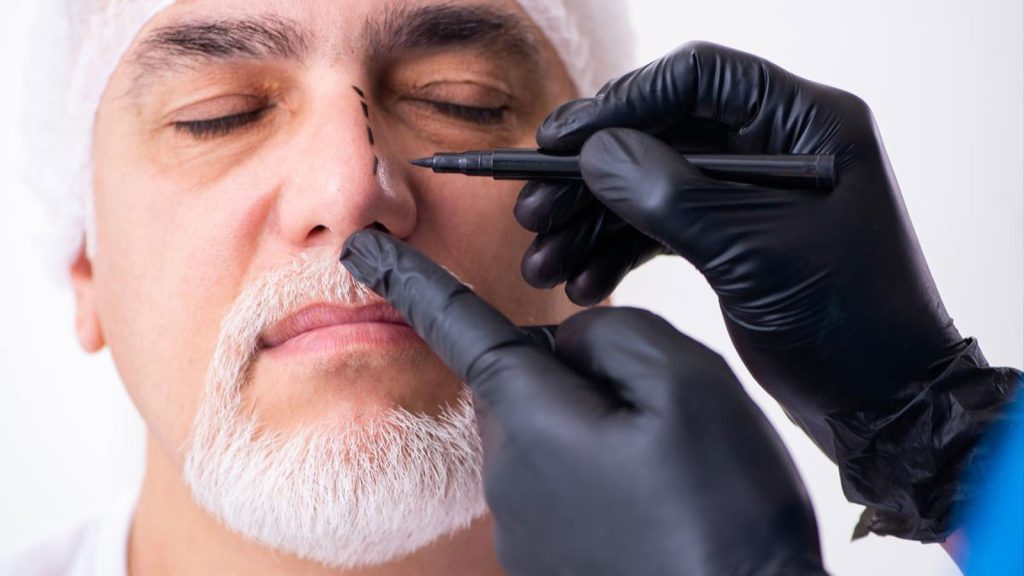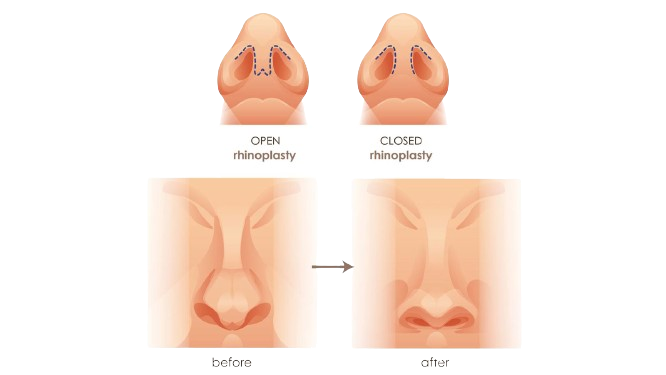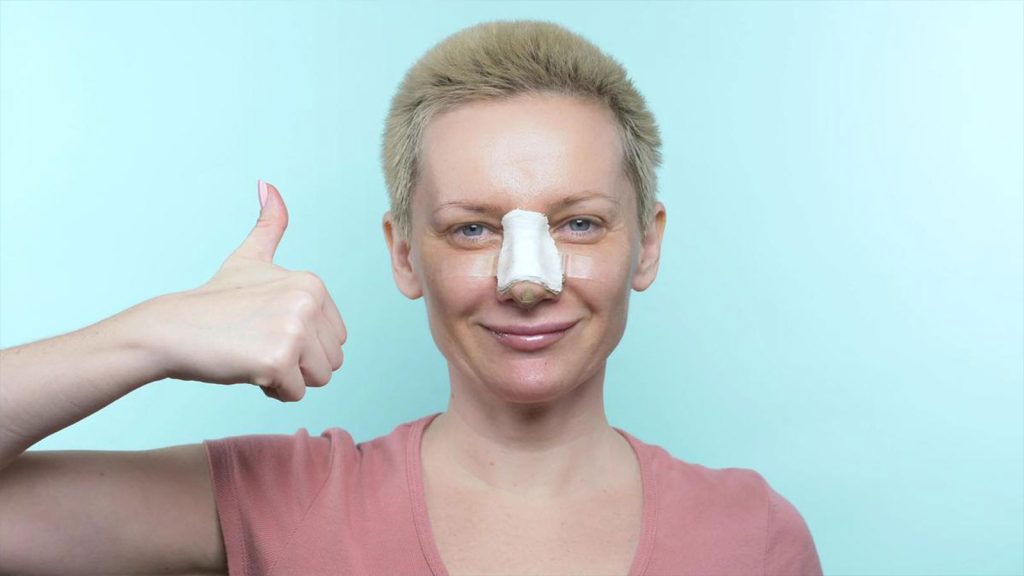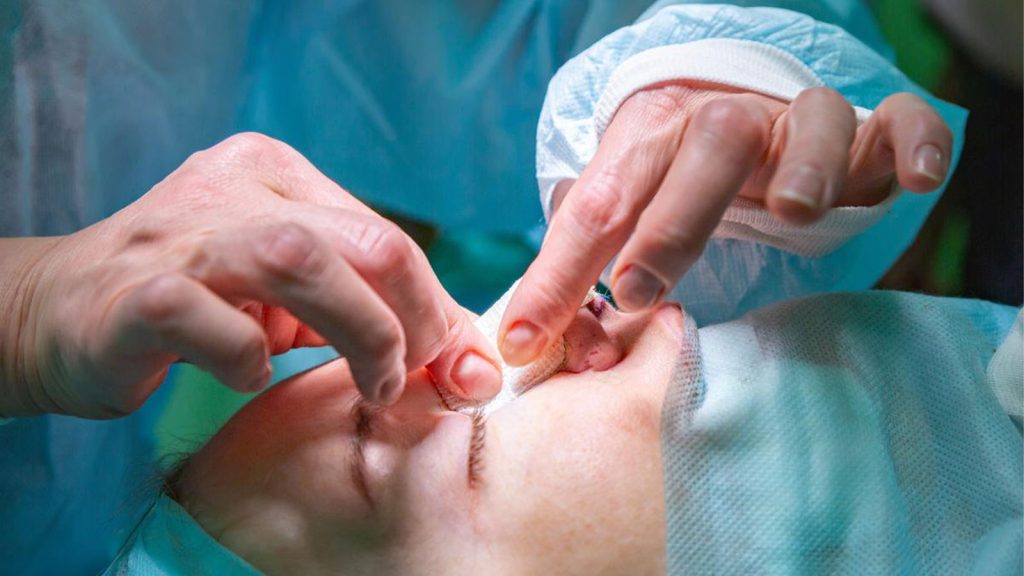Everything You Need to Know About Fleshy Nose Rhinoplasty
The nose is the central point of the face, and its harmony and symmetry directly impact facial beauty. Sometimes, due to accidents, trauma, or even genetics, this part of the face becomes misshapen or excessively large and fleshy. This enlargement can affect facial aesthetics and reduce self-confidence. In such cases, fleshy nose surgery (rhinoplasty) can resolve the issue and reshape the nose to a desired form.
Fleshy nose surgery is considered one of the most challenging types of rhinoplasty because the primary modifications are made to the nasal tip, which is a particularly delicate area. This part contains fat, muscle, and cartilage, and due to its softness, reshaping and correcting it is more difficult. Moreover, the structural adjustments and the thickness of the soft tissue must be assessed individually for each patient. Therefore, performing surgery on a fleshy nose requires the expertise of a highly skilled and experienced surgeon.
To learn more about fleshy nose rhinoplasty, including the techniques used, pre-operative preparations, and post-operative care, continue reading this article from Dr. Benyamin Rahmaty’s website.
Who Needs Fleshy Nose Surgery?
First, we need to understand what qualifies as a fleshy nose. A nose is considered fleshy if it has the following characteristics:
Enlarged skin pores at the tip
Thick and oily skin
weak cartilage
Wide nostrils
Broad nasal base
Not all fleshy noses exhibit all these traits at once. Therefore, they are classified into three types.
The first type is the bulbous nose, which features thick, oily skin and wide nostrils.
The second type is a fleshy nose accompanied by a fractured nasal bone; it usually has oily skin and weak cartilage.
The third type has a broad nasal base. Each type requires a specific surgical technique for correction, tailored by the surgeon.

What Techniques Are Used for Fleshy Nose Rhinoplasty?
The surgical technique chosen for fleshy nose rhinoplasty depends on the desired nasal shape and the specific changes required. Rhinoplasty is not merely a cosmetic procedure; the surgeon must also preserve the function of the nose, avoid damage to blood vessels and nerves, and address issues such as polyps, deviated septum, or airway problems if present.
If only the nasal tip and its anatomy need correction, the closed rhinoplasty technique is used. However, if the septum or upper nasal structures also require modification, open rhinoplasty is recommended.

Closed Rhinoplasty Technique for Fleshy Noses
In closed rhinoplasty, incisions are made around the nose and inside the nostrils. In this method, the nasal septum is not cut, and the nasal skin is not lifted. Instead, the surgeon uses scissors and a scalpel to remove excess cartilage and fat. This technique is commonly used for achieving a natural-looking fleshy nose.

Open Rhinoplasty Technique for Fleshy Noses
In this technique, the nasal septum is incised, and the skin of the nose is lifted. The skin is held up with special instruments, allowing the surgeon to perform corrections such as reducing bone size and reshaping the cartilage. This method is used for fleshy noses that also have additional issues like a large septum, deviation, or crooked nasal wall.

Can the Nose Return to Its Fleshy Form After Surgery?
This is a common question among people considering nose surgery. In the past, due to the lack of complementary techniques for fleshy nose rhinoplasty, there was a chance of the nose reverting to its previous form. However, in recent years, thanks to new tools and advanced methods, this possibility has significantly decreased.
One supportive technique is fat removal, suitable only for those with nasal skin thickness between 3 to 5 mm. In another approach, due to weak nasal bone and the risk of the nasal tip drooping, a cartilage graft is used to stabilize the septum and prevent displacement. This cartilage is taken from the nose itself or from part of the ear and placed in the nasal tip.
Ultimately, if your surgeon is skilled and experienced and chooses the right technique for your nasal structure, the chance of the nose reverting to its fleshy state is virtually zero.

What Preparations Are Necessary for Fleshy Nose Surgery?
Using a CT scan, the nasal anatomy is precisely evaluated. This helps your surgeon recommend the most suitable surgical techniques and nose shape for you.
In addition to this preparation, the following steps are advised to ensure the best outcome and reduce potential side effects:
- If you smoke cigarettes or hookah, quit before surgery. Smoking is strictly prohibited after the operation, and dependence on it may cause you discomfort.
- Before surgery, inform both your surgeon and anesthesiologist about all medications, supplements, and even herbal remedies you are using. Some of these can increase bleeding and surgical risks.
- If your surgeon recommends consulting a psychiatrist, be sure to follow through with that consultation.
How Is Fleshy Nose Surgery Performed?
After selecting the surgical technique, we move on to the actual steps of the procedure. Fleshy nose rhinoplasty typically takes around two hours, and you are usually required to stay one night in the hospital. The surgery consists of the following stages:
anesthesia
For closed rhinoplasty, either general or local anesthesia can be used. In both methods, special medications are injected to numb the nasal area and minimize bleeding. These injections start from the base of the nose and move upward. Once the injections are completed, the face is covered with a sterile surgical drape.
Incisions to Begin Surgery
At this stage, the surgeon makes specific incisions around the nose to minimize damage to blood vessels and nerves. In closed rhinoplasty, the skin over the nasal septum is usually not cut. However, in the open technique, the nasal skin is fully lifted.
Nose Reshaping
After the incisions are made, the surgeon begins reshaping the nose. The main correction usually involves resizing the nasal tip. To achieve this, the surgeon may remove part of the cartilage and fatty tissue to improve symmetry and morphology. Thanks to medical advancements, fleshy nose surgery is now performed using less invasive techniques. Cartilage sculpting and graft placement have made this surgery non-reversible.
More on Nose Reshaping
In bulbous nose surgery, the nostrils are reduced in size to improve the nasal shape. If the nasal septum or nasal bone also require correction—such as in cases of a deviated septum or for achieving a fantasy or semi-fantasy nose—the surgeon must reshape or reduce them. This correction is done using a rasp, osteotome, or ultrasonic device, depending on the patient’s condition.
Cartilage Reduction
If the nasal issue is due to oversized cartilage, the surgeon will remove the excess using scissors or a surgical blade. This is a very delicate step because removing too much cartilage can lead to nasal deformities.
Additional Corrections
Other procedures that may be performed during fleshy nose surgery include correcting internal nasal valve dysfunction, shortening or lengthening the nasal tip, adjusting its rotation, modifying the dome angles, and narrowing the nasal width using interdomal sutures.
Reinforcing the Nasal Septum
In some cases, to achieve better results, the nasal septum bone must be reinforced. Various techniques are available for this, including synthetic implants and homologous cartilage or tissue. Deviation of the central nasal cartilage is a common issue with fleshy noses. To correct it, the surgeon needs to cut and reshape the cartilage.
Suturing and Dressing
After all the necessary corrections are made, the surgeon proceeds to suture the incisions. Absorbable sutures are usually used. To maintain the nose’s shape, splints are placed on both sides and fixed with medical plaster. These are usually removed by the surgeon about seven days after the operation.
What Are the Complications of Fleshy Nose Surgery?
Like any surgery, fleshy nose surgery comes with potential side effects. Pain, dizziness, nasal burning, swelling, and bruising under the eyes are among the most common. Other possible complications include nasal adhesions, airway obstruction, and unsatisfactory results. Choosing an experienced surgeon and carefully following postoperative care can greatly reduce the risk of these issues.
The following complications may also occur, though rarely, in those who undergo fleshy nose surgery:
infection
To prevent this complication, it’s recommended to start taking antibiotics before surgery and continue afterward. Thanks to modern medications, the risk of infection is very low.
Septal hematoma
This is a tender mass that may form on the nasal septum after surgery. It is a rare complication. Treatment involves draining the hematoma and taking antibiotics.
Postoperative Bleeding
Bleeding is a common side effect after fleshy nose rhinoplasty. It’s usually mild and can be controlled with medication.
Damage to Tear Ducts
This issue is typically caused by postoperative swelling and usually resolves as the swelling subsides over a few weeks.
How to Take Care of the Operated Nose
Postoperative care plays a major role in achieving desired results after fleshy nose surgery. In some cases, your surgeon may prescribe corticosteroid injections to enhance the outcome — it’s important to follow the doctor’s instructions precisely.
Surgeons usually recommend patients to follow these guidelines:
- Avoid lifting heavy objects
- Stay away from direct sunlight
- Refrain from exercising for eight weeks
- Maintain a healthy diet
- Take all prescribed medications on time
- Avoid driving for two weeks
- Avoid air and train travel
- Do not wash your face until the splint is removed
- Avoid makeup
- Apply a cold compress three times a day to reduce swelling
Who Should Avoid Fleshy Nose Surgery
Individuals with Body Dysmorphic Disorder (BDD)
This psychiatric condition causes individuals to be severely dissatisfied with their appearance, often imagining exaggerated flaws. It can lead to intense depression or suicidal thoughts. Cosmetic surgery is not beneficial for such individuals and may even worsen their dissatisfaction.
Obstructive Sleep Apnea
Having obstructive sleep apnea doesn’t necessarily mean you’re completely prohibited from undergoing fleshy nose surgery; however, it increases the risk of complications and the need for special postoperative care. If you suffer from airway obstruction during sleep, make sure to consult with your surgeon about possible risks and post-surgery considerations.
Cocaine Use
Snorting cocaine causes severe blood vessel constriction and inflammation of the nasal mucosa. Those who use cocaine are at higher risk of nasal tip collapse and septal inflammation after surgery. It’s recommended to avoid surgery until complete cessation of cocaine use.
Bleeding and Clotting Disorders
Having blood clotting disorders can significantly raise the risk of complications during or after surgery. If you suffer from hemophilia, excessive bleeding, or easy bruising, make sure to inform your doctor beforehand.
Keloid-Prone Patients
Keloid is a rare condition in which the immune system reacts excessively to wounds and injuries. These patients are highly prone to developing scars and excessive tissue growth, so it's best they avoid undergoing rhinoplasty.
Tips for Choosing the Right Surgeon
Choosing a skilled and experienced surgeon is essential for achieving desirable results in fleshy nose rhinoplasty. Proper surgical technique and corrective methods are key to getting the shape you want. If the surgeon lacks expertise, not only might you be dissatisfied with the results, but you could also experience serious complications.
Dr. Benyamin Rahmati, an ENT specialist and cosmetic surgeon, along with his experienced team, is well-qualified to perform fleshy nose rhinoplasty and shape your nose the way you desire. Dr. Rahmati has extensive experience in facial and nasal cosmetic surgery and has published reputable articles in medical journals in the U.S., U.K., and Switzerland.
Fleshy nose surgery is one of the most difficult and complex types of rhinoplasty. The focus of this procedure is on the nasal tip. Due to the presence of soft tissue in this area, reshaping requires both experience and precision. Therefore, it’s essential to consult a specialized nose surgeon for fleshy nose rhinoplasty.



